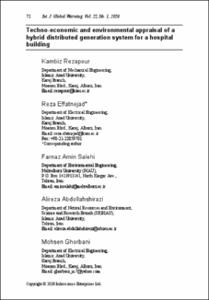Please use this identifier to cite or link to this item:
http://localhost/handle/Hannan/3964
Full metadata record
| DC Field | Value | Language |
|---|---|---|
| dc.contributor.author | Rezapour, Kambiz | - |
| dc.contributor.author | Effatnejad, Reza | - |
| dc.contributor.author | Amin Salehi, Farnaz | - |
| dc.contributor.author | Abdollahshirazi, Alireza | - |
| dc.contributor.author | Ghorbani, Mohsen | - |
| dc.date.accessioned | 2020-11-05T21:53:18Z | - |
| dc.date.available | 2020-11-05T21:53:18Z | - |
| dc.date.issued | 2020 | - |
| dc.identifier.uri | http://localhost/handle/Hannan/3964 | - |
| dc.description.abstract | In this paper, the techno-economic, energy efficiency, and environmental parameters of three different types of distributed generation systems, including high-temperature fuel cells, micro-turbines and photovoltaic (PV) systems were performed for a hospital building in Tehran, Iran using the eQUEST energy simulation tool and HOMER international optimisation model. The demand of electricity and natural gas of the hospital was calculated by the eQUEST software. Based on that, economic parameters, energy efficiency and environmental issues for three distributed generation systems have been evaluated by the HOMER international optimisation model and results are proposed for decision making. The results show that emissions produced by the fuel cell system including F and nitrogen oxides (NOx) are far less than other distributed generation systems. Therefore, the high-temperature fuel cell is more sustainable and affordable from economic and environmental aspects. | en_US |
| dc.language.iso | en | en_US |
| dc.subject | distributed generation; renewable energy; hybrid system; building energy efficiency; eQUEST; HOMER. | en_US |
| dc.title | Techno-economic and environmental appraisal of a hybrid distributed generation system for a hospital building | en_US |
| dc.type | Article | en_US |
| Appears in Collections: | مهندسی ایمنی،بهداشت و محیط زیست | |
Files in This Item:
| File | Description | Size | Format | |
|---|---|---|---|---|
| ISI PAPER-2020-Copy.pdf | 1.02 MB | Adobe PDF |  Preview File |
Full metadata record
| DC Field | Value | Language |
|---|---|---|
| dc.contributor.author | Rezapour, Kambiz | - |
| dc.contributor.author | Effatnejad, Reza | - |
| dc.contributor.author | Amin Salehi, Farnaz | - |
| dc.contributor.author | Abdollahshirazi, Alireza | - |
| dc.contributor.author | Ghorbani, Mohsen | - |
| dc.date.accessioned | 2020-11-05T21:53:18Z | - |
| dc.date.available | 2020-11-05T21:53:18Z | - |
| dc.date.issued | 2020 | - |
| dc.identifier.uri | http://localhost/handle/Hannan/3964 | - |
| dc.description.abstract | In this paper, the techno-economic, energy efficiency, and environmental parameters of three different types of distributed generation systems, including high-temperature fuel cells, micro-turbines and photovoltaic (PV) systems were performed for a hospital building in Tehran, Iran using the eQUEST energy simulation tool and HOMER international optimisation model. The demand of electricity and natural gas of the hospital was calculated by the eQUEST software. Based on that, economic parameters, energy efficiency and environmental issues for three distributed generation systems have been evaluated by the HOMER international optimisation model and results are proposed for decision making. The results show that emissions produced by the fuel cell system including F and nitrogen oxides (NOx) are far less than other distributed generation systems. Therefore, the high-temperature fuel cell is more sustainable and affordable from economic and environmental aspects. | en_US |
| dc.language.iso | en | en_US |
| dc.subject | distributed generation; renewable energy; hybrid system; building energy efficiency; eQUEST; HOMER. | en_US |
| dc.title | Techno-economic and environmental appraisal of a hybrid distributed generation system for a hospital building | en_US |
| dc.type | Article | en_US |
| Appears in Collections: | مهندسی ایمنی،بهداشت و محیط زیست | |
Files in This Item:
| File | Description | Size | Format | |
|---|---|---|---|---|
| ISI PAPER-2020-Copy.pdf | 1.02 MB | Adobe PDF |  Preview File |
Full metadata record
| DC Field | Value | Language |
|---|---|---|
| dc.contributor.author | Rezapour, Kambiz | - |
| dc.contributor.author | Effatnejad, Reza | - |
| dc.contributor.author | Amin Salehi, Farnaz | - |
| dc.contributor.author | Abdollahshirazi, Alireza | - |
| dc.contributor.author | Ghorbani, Mohsen | - |
| dc.date.accessioned | 2020-11-05T21:53:18Z | - |
| dc.date.available | 2020-11-05T21:53:18Z | - |
| dc.date.issued | 2020 | - |
| dc.identifier.uri | http://localhost/handle/Hannan/3964 | - |
| dc.description.abstract | In this paper, the techno-economic, energy efficiency, and environmental parameters of three different types of distributed generation systems, including high-temperature fuel cells, micro-turbines and photovoltaic (PV) systems were performed for a hospital building in Tehran, Iran using the eQUEST energy simulation tool and HOMER international optimisation model. The demand of electricity and natural gas of the hospital was calculated by the eQUEST software. Based on that, economic parameters, energy efficiency and environmental issues for three distributed generation systems have been evaluated by the HOMER international optimisation model and results are proposed for decision making. The results show that emissions produced by the fuel cell system including F and nitrogen oxides (NOx) are far less than other distributed generation systems. Therefore, the high-temperature fuel cell is more sustainable and affordable from economic and environmental aspects. | en_US |
| dc.language.iso | en | en_US |
| dc.subject | distributed generation; renewable energy; hybrid system; building energy efficiency; eQUEST; HOMER. | en_US |
| dc.title | Techno-economic and environmental appraisal of a hybrid distributed generation system for a hospital building | en_US |
| dc.type | Article | en_US |
| Appears in Collections: | مهندسی ایمنی،بهداشت و محیط زیست | |
Files in This Item:
| File | Description | Size | Format | |
|---|---|---|---|---|
| ISI PAPER-2020-Copy.pdf | 1.02 MB | Adobe PDF |  Preview File |
